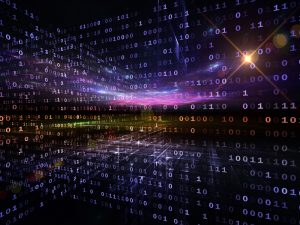May 22, 2024 — Researchers at Los Alamos National Laboratory have developed a tensor network approach that solves real-world neutron transport equations. As described in the Journal of Computational Physics, the approach achieved world-record compression of memory, on the yottabyte scale — yottabytes are the largest unit of measurement and equivalent to a million trillion megabytes — and demonstrated efficiency and accuracy in solving partial differential equations used in critical nuclear science applications.

“Tensor network techniques are forming a new frontier of mathematical modeling that enable numerical solutions of high-dimensional partial differential equations at unprecedented speed,” said Duc Truong, Los Alamos researcher on the project.
Breaking the Curse of Dimensionality
The team’s tensor network approach uses data science and machine learning (an application of artificial intelligence) to break the “curse of dimensionality,” the multiple issues that arise with increased dimensionality in large computational tasks. Even high-performance computers are limited by the curse of dimensionality.
The researchers developed a mixed tensor-train (TT) plus quantized tensor-train (QTT) method and applied it to a specific task: solving the time-independent Boltzmann neutron transport equations in Cartesian geometry. These three-dimensional equations describe neutron transport resulting from collisions with atoms; one learns how fast the neutrons are moving and where they are going.
“Used in neutron transport models, tensor network techniques may help unlock neutron behavior in many settings,” said Mario Ortega, fellow Los Alamos researcher. “Neutron transport equations are useful in understanding processes in nuclear reactors and in particle beams employed in science and industry.”
Achieving Record Compression
The team validated their approach using two examples of three-dimensional neutron transport problems, currently solved by the Laboratory’s PARallel time-dependent discrete ordinate (PARTISN) code, developed over decades to address neutron transport problems. Executing the TT/QTT method on a standard desktop computer, the team achieved the record of compressing the storage of terabyte-sized neutron flow to megabytes. That compression was achieved while enabling full access to megabyte-sized tensor network representations of yottabyte-sized transport matrix operators. The TT/QTT method also exhibited exceptional efficiency in compute time and memory usage, significantly outperforming the PARTISN code.
“When comparing the mixed tensor train plus quantized tensor train approach against traditional methods for solving Boltzmann neutron transport equations, we found that efficiency, speed, memory and accuracy all favor the new approach,” said Boian Alexandrov, the senior scientist of the project.
The research team aims to extend their approach to study problems with multiple materials and the use of tensor networks with spherical and cylindrical neutron transport equations with non-linearity.
Paper: “Tensor networks for solving the time-independent Boltzmann neutron transport equation.” Journal of Computational Physics. DOI: 10.1016/j.jcp.2024.112943
Funding: This work was supported by the Laboratory Directed Research and Development program of Los Alamos National Laboratory, and in part by Institutional Computing Program at Los Alamos.
Source: LANL

























































